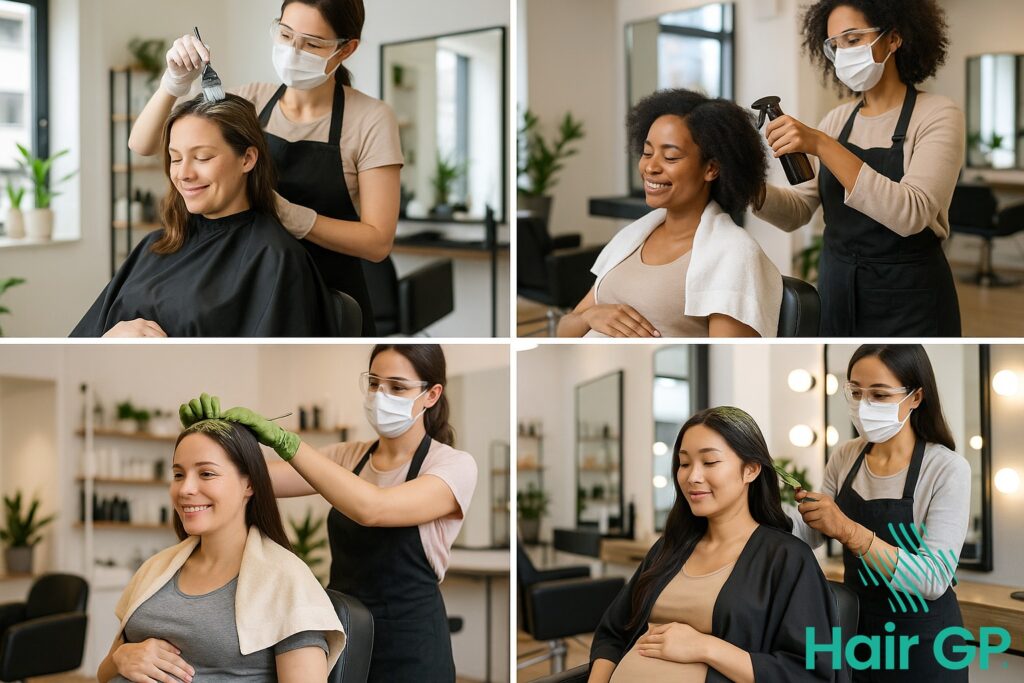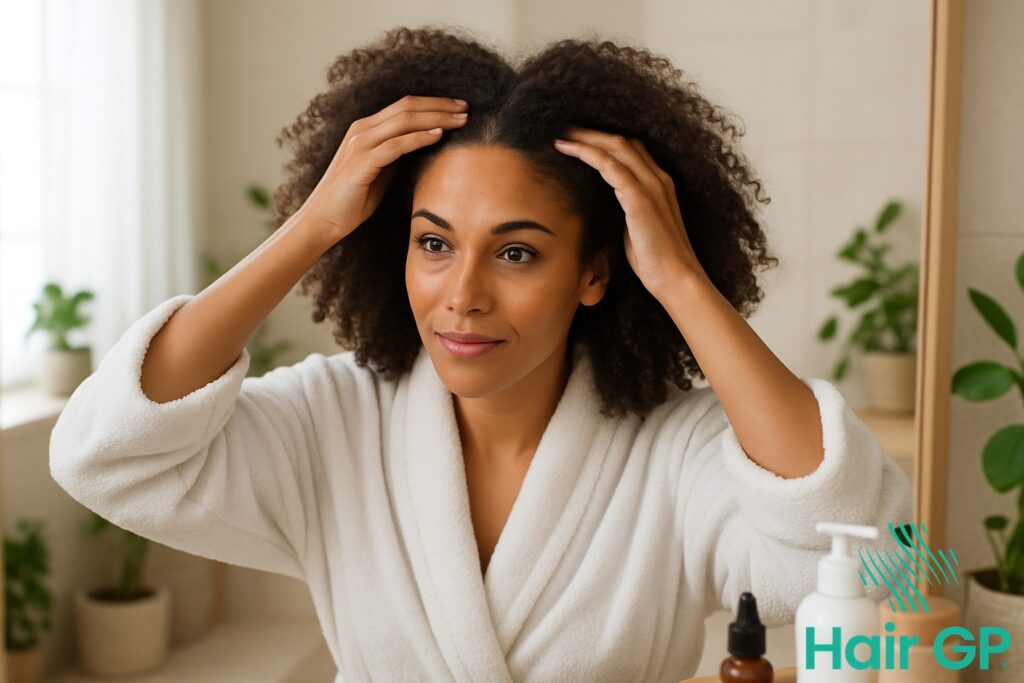Introduction
For many women, maintaining their appearance during pregnancy includes continuing their regular hair care routine, yet hair colouring during pregnancy remains one of the most debated beauty topics amongst expectant mothers. With conflicting advice from friends, family, and even some healthcare providers, pregnant women often find themselves confused about whether hair dye poses risks to their developing baby.
The concern stems from questions about chemical exposure and whether the substances in hair colouring products can be absorbed through the scalp and potentially affect fetal development. Some sources suggest complete avoidance, whilst others claim it’s perfectly safe, leaving many women uncertain about the best course of action for maintaining a healthy pregnancy whilst feeling confident about their appearance.
This comprehensive guide cuts through the confusion by examining the scientific evidence surrounding hair dye safety during pregnancy. We’ll explore the different types of hair colouring chemicals and how they interact with your body, review current medical research and expert recommendations, and discuss safer alternatives that allow you to maintain your desired look throughout pregnancy.
Additionally, we’ll cover the importance of timing treatments according to your trimester, essential safety precautions to minimise any potential risks, and considerations for other chemical hair treatments. By the end of this article, you’ll have the evidence-based information needed to make informed decisions about hair colouring during pregnancy that align with both your personal preferences and your baby’s wellbeing.
Key Takeaways – TL/DR
- Most hair dyes are considered safe during pregnancy when proper precautions are taken
- Waiting until the second trimester is often recommended by healthcare professionals
- Semi-permanent dyes and natural alternatives like henna pose lower risks than permanent dyes
- Professional salon application with good ventilation is safer than at-home treatments
Audio Blog Version
Understanding Hair Dye Chemicals and Safety Concerns
Hair dye chemicals present unique considerations during pregnancy due to their complex composition and potential for scalp absorption. Understanding the specific ingredients in different hair colouring products helps expectant mothers make informed decisions about their beauty routines whilst considering potential chemical exposure risks.
Permanent vs Semi-Permanent Hair Dye Ingredients
Permanent hair dyes contain stronger hair dye chemicals, including ammonia and hydrogen peroxide, which work by opening the hair shaft to deposit colour deep within the cortex [1]. These formulations often include para-phenylenediamine (PPD) and other aromatic amines that enable long-lasting colour retention. In contrast, semi-permanent options use gentler ingredients like direct dyes that coat the hair shaft surface without penetrating deeply. Semi-permanent formulations typically avoid harsh alkalising agents, resulting in reduced chemical exposure through the scalp [2].
How Hair Dye Affects Your Body During Pregnancy
Pregnancy hormones increase scalp sensitivity and may enhance absorption of harmful chemicals through the skin barrier. The body’s increased blood flow and altered metabolism during pregnancy can potentially affect how chemical exposure is processed. Whilst studies suggest minimal systemic absorption of hair dye ingredients, the combination of hormonal changes and increased skin permeability warrants careful consideration when choosing hair colouring methods [3].
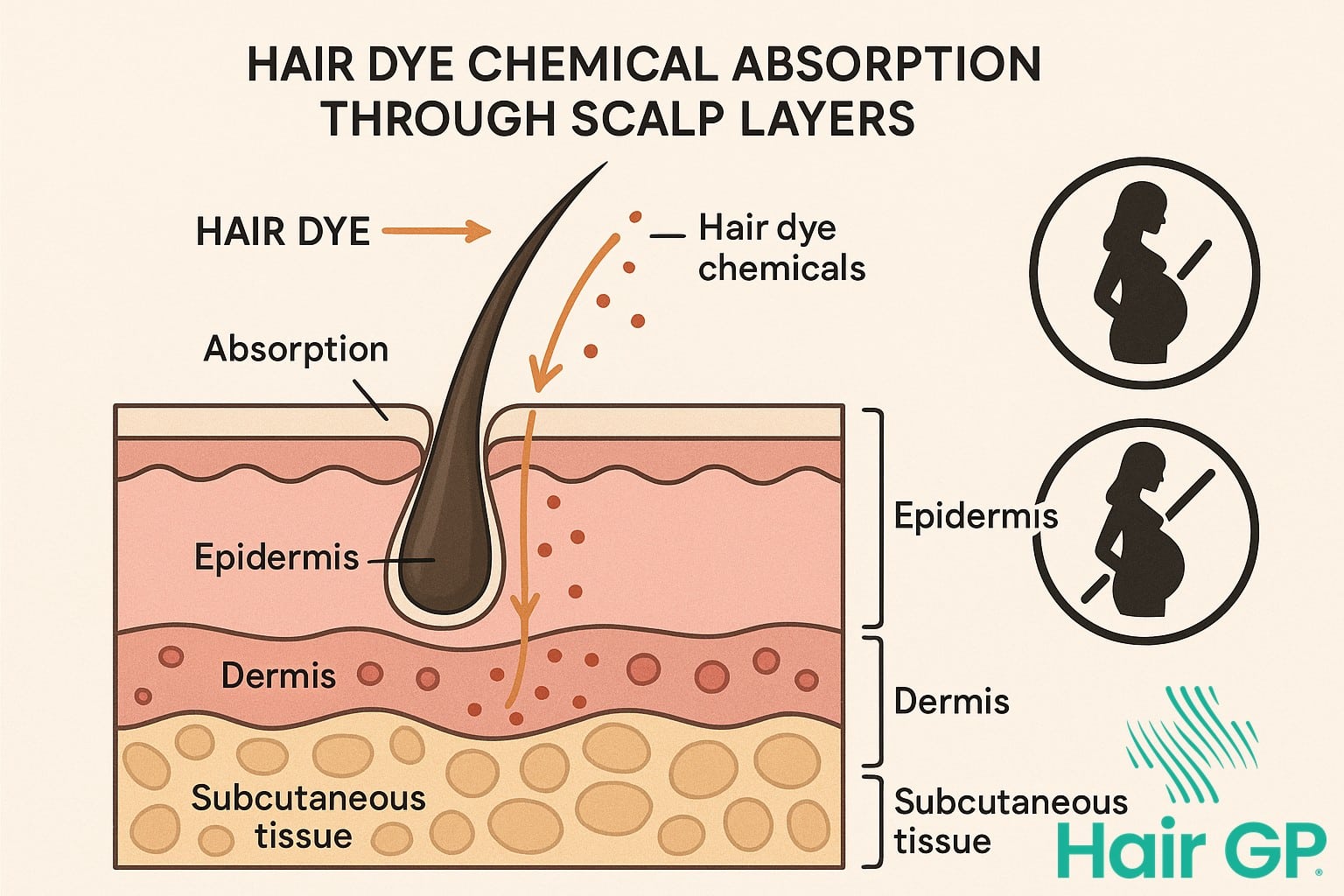
Medical Expert Opinions and Research Findings
Leading medical authorities, including the Cleveland Clinic, maintain that occasional hair colouring during pregnancy poses minimal risk when proper precautions are followed. Current research findings indicate that the absorption of hair dye chemicals through the scalp is extremely limited, with negligible amounts reaching the bloodstream. Medical experts emphasise that maintaining a healthy pregnancy involves reasonable risk assessment rather than complete chemical avoidance. The NHS website start for life advises that ‘Most research shows that it’s safe to dye or colour your hair while pregnant’.
Obstetric specialists and experienced midwife practitioners generally agree that semi-permanent and temporary hair dyes present even lower risks than permanent formulations. The scientific consensus suggests that any potential impact on the fetus from occasional hair colouring is theoretically minimal. However, medical professionals consistently recommend postponing hair treatments until after the first trimester when possible, as this represents the most critical period of foetal development.
Contemporary research findings support the position that pregnant women can safely colour their hair with appropriate timing and product selection. Healthcare providers typically advise ensuring adequate ventilation, using gloves, and following manufacturer instructions precisely. This evidence-based approach allows expectant mothers to make informed decisions whilst prioritising both maternal wellbeing and foetal safety throughout their pregnancy journey.
Safe Hair Coloring Options During Pregnancy
Expectant mothers don’t need to sacrifice their hair colour goals during pregnancy. Several safer alternatives and modified techniques can help maintain beautiful hair whilst minimising potential risks to both mother and baby.
Natural Alternatives: Henna and Plant-Based Dyes
Henna dyes represent one of the safest options for pregnant women seeking natural hair colour enhancement. Pure henna, derived from the Lawsonia inermis plant, contains no synthetic chemicals and provides rich red-orange tones. When selecting henna products, ensure they contain 100% pure henna without additives like para-phenylenediamine (PPD). Other plant-based alternatives include indigo for darker shades, cassia for golden highlights, and temporary dyes made from natural ingredients. These options work by coating the hair shaft rather than penetrating deeply, making them gentler alternatives to conventional chemical treatments.
Professional Salon Techniques for Pregnant Women
Professional colourists can employ techniques that minimise scalp contact during pregnancy. Foil highlighting and balayage methods keep colour products away from the scalp, reducing absorption risks whilst achieving beautiful results. Lowlights and semi permanent color applications can refresh your look without full scalp coverage. These techniques focus on mid-lengths and ends of hair, creating dimension whilst maintaining safety. Professional salons also provide proper ventilation systems that reduce chemical exposure through inhalation, making the colouring process safer for expectant mothers.
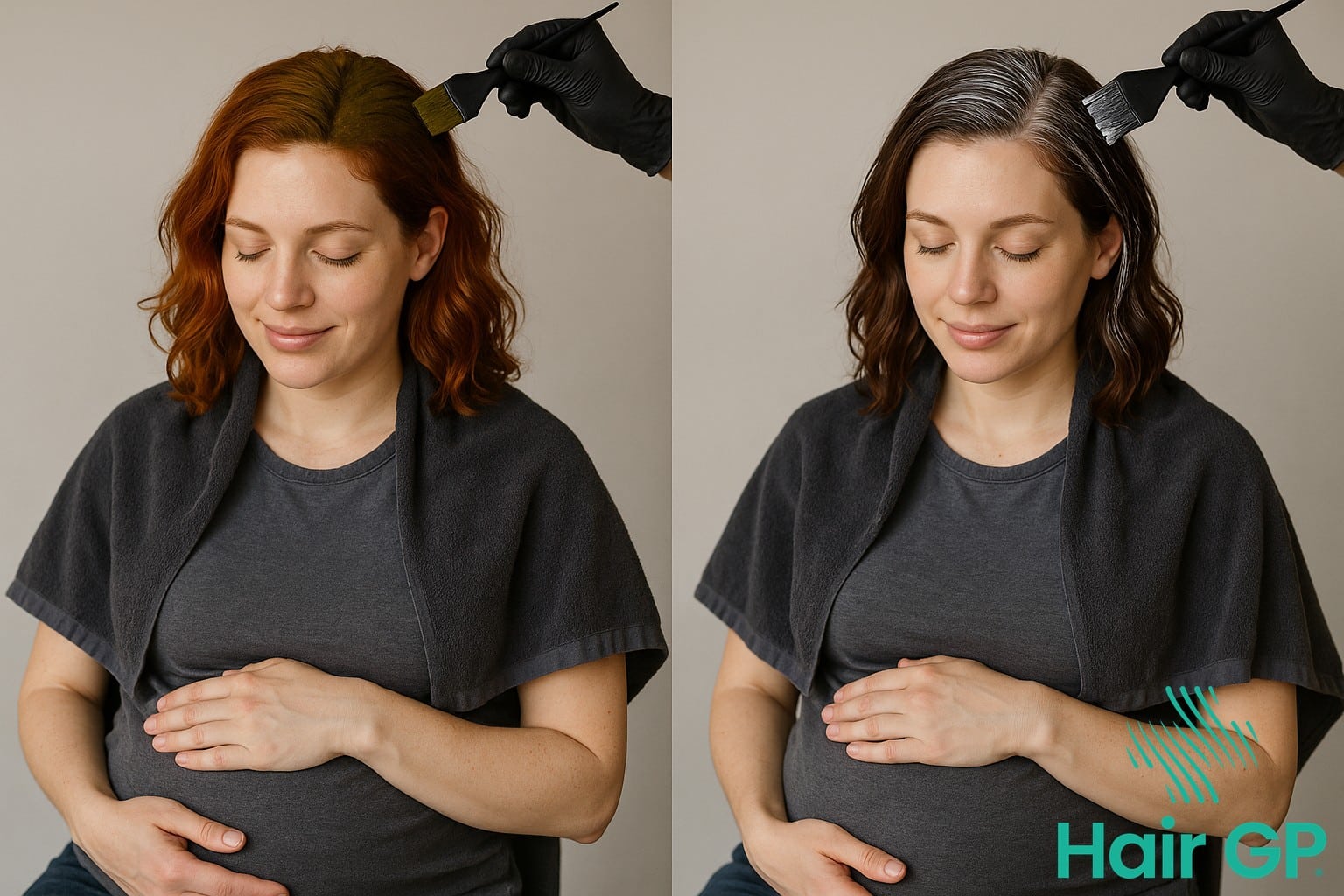
Timing Your Hair Treatment by Trimester
Timing hair colouring treatments during pregnancy requires understanding how each trimester presents different considerations for both maternal comfort and fetal development. Strategic planning helps expectant mothers make informed decisions whilst prioritising safety throughout their pregnancy journey.
First Trimester Considerations
The first trimester represents the most critical period for fetal organ development, leading many healthcare providers to recommend postponing chemical hair treatments . During these initial twelve weeks, the baby to be undergoes rapid cellular division and organ formation, making this trimester particularly sensitive to potential chemical exposures. Many women also experience heightened nausea and chemical sensitivities during the first trimester, making salon visits uncomfortable. The precautionary approach during this period reflects the principle of minimising any unnecessary chemical exposure when fetal development is most vulnerable.
Second and Third Trimester Guidelines
The second trimester and beyond typically present safer timing options for hair treatments, as major organ development has largely completed [4]. The second or third trimester allows for more comfortable positioning during salon visits, though late pregnancy may present logistical challenges due to physical discomfort.
Safety Precautions and Best Practices
When choosing to colour your hair during pregnancy, several essential safety measures can help ensure a positive experience. Proper ventilation is crucial whether you’re at home or visiting a hair salon. Open windows and ensure adequate airflow to minimise inhalation of chemical fumes.
Always perform a patch test before any hair treatment, particularly if you’re trying a new product or visiting a different hair stylist. Apply a small amount of the colouring product to a discreet area of skin and wait 24-48 hours to check for allergic reactions. This precaution becomes more important during pregnancy when skin sensitivity may increase.
Consider professional application at a reputable salon rather than home treatments. An experienced hairdresser can apply products more precisely, reducing contact with your healthy scalp and minimising chemical exposure. Professional hair stylists use higher-quality products and maintain better ventilation systems.
Consult your healthcare provider if you have concerns about specific products or experience unusual symptoms during or after colouring treatments.
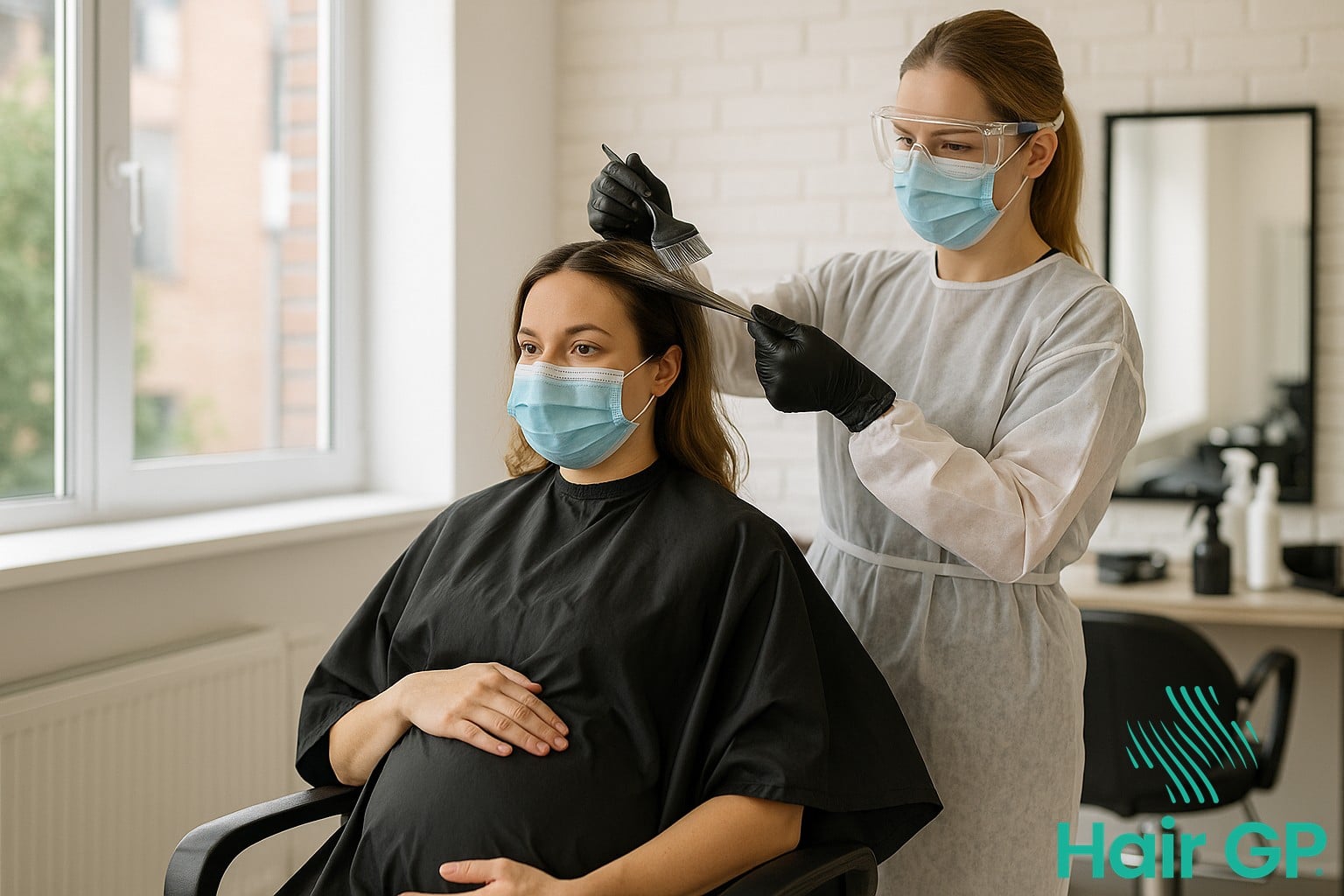
Alternative Hair Treatments and Considerations
Beyond hair colouring, many pregnant women enquire about other hair treatments and their safety profiles. Chemical treatments such as relaxers require careful consideration, as they often contain stronger formulations than standard dyes. Most healthcare professionals recommend postponing relaxers until after the first trimester, when foetal development is more established. Eyebrow tinting represents a lower-risk alternative, as the application area is minimal and exposure is significantly reduced.
For breastfeeding mothers, concerns shift from foetal exposure to potential milk contamination. Fortunately, most other hair treatments pose minimal risk during lactation, as chemicals are unlikely to transfer into breast milk in meaningful quantities. Women should maintain proper ventilation during chemical treatments and consider patch testing to identify potential sensitivities developed during pregnancy. Consulting healthcare providers ensures personalised guidance based on individual circumstances.
Conclusion
Making informed decisions about hair colouring during pregnancy doesn’t have to be overwhelming. Throughout this comprehensive guide, we’ve explored the essential safety considerations that every expectant mother should understand. The key takeaway is that pregnant women can maintain their desired appearance whilst prioritising their health and their baby’s wellbeing.
The evidence clearly shows that semi-permanent hair dye options and natural alternatives present significantly lower risks compared to permanent chemical formulations. Timing your hair colouring sessions appropriately, ensuring proper ventilation, and following safe application techniques can further minimise potential exposure to harmful substances.
Most importantly, every pregnancy journey is unique, and what works for one person may not be suitable for another. Consulting with your healthcare provider or midwife before making any decisions about hair colouring during pregnancy ensures that your individual circumstances are properly considered. They can provide personalised guidance based on your medical history and current health status.
Remember that maintaining a healthy pregnancy involves making informed choices rather than avoiding everything entirely. With proper precautions, professional guidance, and careful product selection, you can confidently navigate your hair care routine throughout this special time. Your wellbeing and your baby’s safety remain the top priority, but this doesn’t mean sacrificing your personal style and confidence.
Frequently Asked Questions
Most medical experts recommend waiting until after the first trimester to minimize any potential risks during the critical organ development period, though no definitive harm has been proven from hair dye use in early pregnancy.
Pure, natural henna is generally considered safe during pregnancy as it doesn’t contain the harsh chemicals found in conventional hair dyes, though you should ensure you’re using 100% pure henna without additives.
Professional hair salons with good ventilation are actually safer than home application, as stylists can minimize scalp contact and ensure proper safety precautions are followed.
Hair dye is considered safe while breastfeeding since the chemicals don’t transfer into breast milk in significant amounts, but maintaining good ventilation and safety practices is still recommended.
References
- Antignac E, Nohynek GJ, Re T, Clouzeau J, Toutain H. Safety of botanical ingredients in personal care products/cosmetics. Food Chem Toxicol. 2011. PMID: 21111022
- Loretz LJ, Api AM, Babcock L, Barraj LM, Burdick J, Cater KC et al.. Exposure data for cosmetic products: facial cleanser, hair conditioner, and eye shadow. Food Chem Toxicol. 2008. PMID: 18243463
- Bluhm EC, Daniels J, Pollock BH, Olshan AF. Maternal use of recreational drugs and neuroblastoma in offspring: a report from the Children's Oncology Group (United States). Cancer Causes Control. 2006. PMID: 16633913
- Ornoy A, Reece EA, Pavlinkova G, Kappen C, Miller RK. Effect of maternal diabetes on the embryo, fetus, and children: congenital anomalies, genetic and epigenetic changes and developmental outcomes. Birth Defects Res C Embryo Today. 2015. PMID: 25783684

